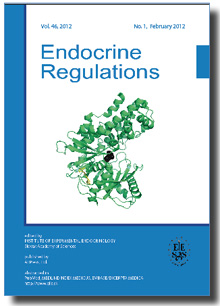Journal info
|
||
Select Journal
Journals
Bratislava Medical Journal Ekologia - Ecology Endocrine Regulations 2015 2014 2013 2012 2011 2010 2009 2008 2007 2006 2005 2004 2003 General Physiology and Biophysics Neoplasma Acta Virologica Studia Psychologica Cardiology Letters Psychológia a patopsych. dieťaťa Kovove Materialy-Metallic Materials Slovenská hudba 2025Webshop Cart
Your Cart is currently empty.
Info: Your browser does not accept cookies. To put products into your cart and purchase them you need to enable cookies.
Endocrine Regulations Vol.39, p.127-131, 2005 |
||
| Title: PREMATURE ANDROGENIC ALOPECIA AND INSULIN RESISTANCE. MALE EQUIVALENT OF POLYCYSTIC OVARY SYNDROME? | ||
| Author: L. STARKA, M. DUSKOVA, I. CERMAKOVA, J. VRBIKOVÁ, M. HILL | ||
| Abstract: Background. Polycystic ovary syndrome (PCOS), the most frequent endocrinopathy in women with estimated prevalence of 5-10 %, is characterised by a hormonal and metabolic imbalance of polygene autosomal trait. The complexity of symptoms and genetic base started up the hypothesis on the existence of male equivalent of PCOS. Precocious loss of hair before 30 years of age was suggested as one of the male symptoms of this syndrome. Objectives. The aim was to confirm the association of lower levels of follicle stimulating hormone (FSH) and sexual hormone binding globulin (SHBG) or higher free androgen index (FAI) in premature balding men with a reduced insulin sensitivity. Patients/Methods. The study included 30 men with premature hair loss (defined as grade 3 vertex or more on the alopecia classification scale by Hamilton with Norwood modification) starting before 30 years of age. The hormonal values of the investigated group were compared with those regarded as normal reference values obtained in a group of 256 males in the age of 20-40 years during the Czech population study of iodine deficiency. In all men with premature baldness besides hormonal level determinations insulin tolerance test was carried out. Results. The observed group was divided into two subgroups. The first one showed similar hormonal changes as women with PCOS, namely subnormal SHBG, FSH or increased FAI. The other had either no anomalies in steroid spectrum or only lower SHBG. The groups did not differ either in BMI or in age. The group with hormonal profile resembling that of women with PCOS, showed significantly higher insulin resistance than the group without these changes. Conclusions. The findings are consistent with the hypothesis that at least a part of the men with premature androgenic alopecia could be considered as a male equivalent of the polycystic ovary syndrome of the women. These premature balding men represent a risk group for the development of impaired glucose tolerance or diabetes mellitus type 2. |
||
| Keywords: Premature balding – Androgenic alopecia – Polycystic ovary syndrome – Insulin resistance | ||
| Year: 2005, Volume: 39, Issue: 4 | Page From: 127, Page To: 131 | |
|
Price:
9.00 €
|
||
|
|
||

